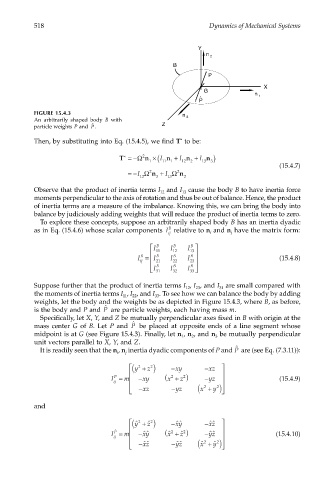Page 537 - Dynamics of Mechanical Systems
P. 537
0593_C15_fm Page 518 Tuesday, May 7, 2002 7:05 AM
518 Dynamics of Mechanical Systems
Y
n
2
B
P
X
G
n 1
ˆ
P
FIGURE 15.4.3
n 3
An arbitrarily shaped body B with
ˆ
particle weights P and . Z
P
*
Then, by substituting into Eq. (15.4.5), we find T to be:
T =−Ω 2 I n + I n + I n )
*
n ×( 11 1
1 12 2 13 3
(15.4.7)
=−I Ω 2 n + I Ω 2 n
12 3 13 2
Observe that the product of inertia terms I and I cause the body B to have inertia force
12
13
moments perpendicular to the axis of rotation and thus be out of balance. Hence, the product
of inertia terms are a measure of the imbalance. Knowing this, we can bring the body into
balance by judiciously adding weights that will reduce the product of inertia terms to zero.
To explore these concepts, suppose an arbitrarily shaped body B has an inertia dyadic
as in Eq. (15.4.6) whose scalar components I B relative to n and n have the matrix form:
ij i j
I B I B I
B
B
11 12 13
I = I B I B I (15.4.8)
B
ij 21 22 23
I B I B I
B
31 32 33
Suppose further that the product of inertia terms I , I , and I are small compared with
23
31
12
the moments of inertia terms I , I , and I . To see how we can balance the body by adding
11
22
33
weights, let the body and the weights be as depicted in Figure 15.4.3, where B, as before,
ˆ
P
is the body and P and are particle weights, each having mass m.
Specifically, let X, Y, and Z be mutually perpendicular axes fixed in B with origin at the
mass center G of B. Let P and P ˆ be placed at opposite ends of a line segment whose
midpoint is at G (see Figure 15.4.3). Finally, let n , n , and n be mutually perpendicular
1
3
2
unit vectors parallel to X, Y, and Z.
ˆ
It is readily seen that the n , n inertia dyadic components of P and are (see Eq. (7.3.11)):
P
i
j
( y + ) − xy − xz
2
2
z
I = m − xy ( x + ) − yz (15.4.9)
2
P
2
z
ij
− − ( x + )
2
2
xz yz y
and
( y ˆ + ) − xy ˆ ˆ − xz ˆˆ
2
2
z ˆ
I = m − xy ˆ ˆ ( x ˆ + ) − yz ˆˆ (15.4.10)
P ˆ
2
z ˆ
2
ij
y ˆ
− − ( x ˆ + )
2
2
xz ˆˆ yz ˆˆ 

